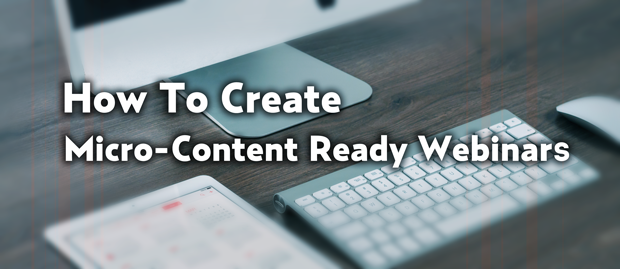Webinars and other types of long-form content are time intensive projects. A team will devote a lot of hours and energy toward creating a great webinar. You want to make sure that this effort is well worth it. While a certain percentage of your target audience will be thrilled to watch the entire webinar, a much larger segment will get more out of specific pieces of the webinar. When you’re used to creating a webinar and then moving on to the next piece of long-form content, the idea of turning webinars into micro-content may seem overwhelming. In time, you’ll learn to integrate the following micro-content strategies into your content creation schedule so that you can develop micro-content quickly and effectively.
Plan your micro-content while you’re planning your webinars
You’ll spend a lot less time going back and creating micro-content once the webinar is done if you’re making plans for this additional content as you go. As you develop a content creation schedule for the coming month, start by planning time for webinars and other high investment types of content such as ebooks and whitepapers. Then start looking for opportunities to develop micro-content and to use premium content in multiple types of long-form content. For example, if you create an infographic for a webinar, you may be able to use it an ebook as well.
Include high quality photographs, graphics, and other visuals
High resolution images are key for micro-content success, particularly on social media. Consider the fact that tweets with images receive 18 percent more clicks, 89 percent more favorites, and 150 percent more retweets. Look for high quality graphics and other visuals that are relevant for the given content. Including visuals for the sake of including visuals won’t actually give your micro-content any leverage. Once you’ve finished the webinar, you can use your images to share small, easy to digest segments of it on social media and your blog.
Divide it into logical segments
While some users will be interested in watching the entire webinar at once, many users would rather watch it in shorter segments. Some people will watch the whole thing in time while other people will pick and choose the segments that are most helpful for them. Dividing your webinar into logical segments right from the start makes this process simpler. You’ll be able to post the webinar in shorter segments immediately, and you’ll have a better idea how to create additional content from the webinar based around these topics.
Pay attention to the micro-content that resonates with your target audience
Depending on your particular target audience, some micro-content is going to be more effective than other types of content. It’s important to pay attention to what does and doesn’t work well so that you can focus on the best channels. For example, maybe you get the highest return on your investment with Facebook updates, YouTube videos, and Pinterest pins. If you don’t get a lot of response from Twitter or Instagram, make these channels a lower priority.
Learning how to turn webinars into micro-content isn’t something that happens all at once. Developing new content creation tactics takes time and effort for it to become automatic. Pay attention to micro-content that resonates with your target audience and build on its success.
